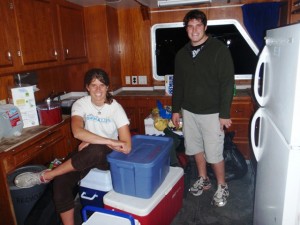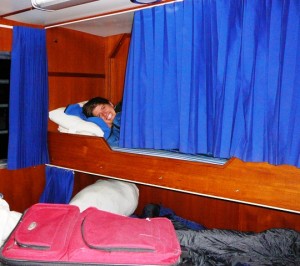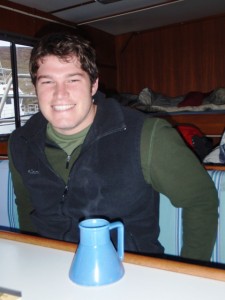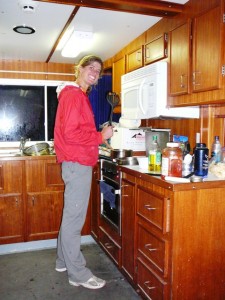I had never been on a boat trip longer than a day before beginning field research aboard the R/V Shearwater, and I was pleasantly surprised to find that there was a full kitchen area and sleeping quarters aboard, as well as tons of deck space for our CTD (conductivity, temperature, depth sensor) and net tow work and a bunch of comfy seats on the flying bridge for bird observations. After loading up the boat with our supplies and instruments, we took a quick dinner break with Jen (who was nice enough to help us get situated on the boat) at “The Brewhouse†which was delicious, then retired to the sleeping quarters for a quick sleep.
The first morning, as with all other mornings on the R/V Shearwater, started bright and early with a quick breakfast and a hot cup of coffee (in a sweet nautical mug).
We then put on our bright red work pants and boots and headed out to the deck to begin collecting data. At each station, we would first perform our net tow, then stop to collect CTD data. While the CTD was being lowered to around 100 meters, Kristen and I would often grab a quick snack of trail mix or redvines before returning to the deck to retrieve the device. After the CTD was secured, we would climb up to the flight bridge, where the rest of the Biologists were waiting with binoculars, field guides, and the Husky computer to begin bird observations.
After a day full of net tows and bird observations, we cleaned up our equipment and went into the cabin to cook dinner, look over some of our data, and relax with a game of cribbage before we began an intense night of spotlight netting and banding off the shore of Santa Barbara Island.
This would generally last from a little after sundown when the scientists from Santa Barbara Island would come aboard and help us set up a banding station to around midnight, when we had decided we had banded enough birds for the night (mostly Xantus’s Murrelets, but we banded a few Ashy Storm-Petrels and Cassin’s Auklets as well). We caught around 20 birds on a good night, sometimes a few more if we had the time or if the birds were particularly plentiful. At this point in the night, we were completely exhausted, and quickly retired to our bunks so we could get as much sleep as possible before starting again the next day.
Life on land is not nearly as fun as life onboard the R/V Shearwater!




